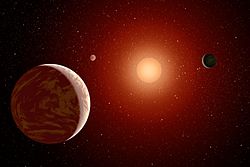| Observation data Epoch J2000 Equinox J2000 | |
|---|---|
| Constellation | Dorado |
| Right ascension | 04h 09m 15.66834s [1] |
| Declination | −53° 22′ 25.2900″ [1] |
| Apparent magnitude (V) | 11.79 [2] |
| Characteristics | |
| Spectral type | M3.5V [3] |
| B−V color index | 1.480±0.008 [2] |
| Astrometry | |
| Radial velocity (Rv) | 58.30±0.24 [1] km/s |
| Proper motion (μ) | RA: 1046.236±0.019 mas/yr [1] Dec.: 584.166±0.023 mas/yr [1] |
| Parallax (π) | 66.0705±0.0172 mas [1] |
| Distance | 49.36 ± 0.01 ly (15.135 ± 0.004 pc) |
| Absolute magnitude (MV) | 10.91 [2] |
| Details | |
| Mass | 0.405±0.010 [4] M☉ |
| Radius | 0.409+0.017 −0.016 [4] R☉ |
| Luminosity | 0.02163±0.00063 [4] L☉ |
| Surface gravity (log g) | 4.87 [5] cgs |
| Temperature | 3,460+76 −74 [4] K |
| Metallicity [Fe/H] | 0.1±0.1 [6] dex |
| Rotation | 61.0±0.3 d [7] |
| Rotational velocity (v sin i) | 0.85 [8] km/s |
| Age | 5 [9] Gyr |
| Other designations | |
| GJ 163, HIP 19394, LHS 188, LTT 1881 [10] | |
| Database references | |
| SIMBAD | data |

Gliese 163 is a faint red dwarf star with multiple exoplanetary companions in the southern constellation of Dorado. Other stellar catalog names for it include HIP 19394 and LHS 188. [10] It is too faint to be visible to the naked eye, having an apparent visual magnitude of 11.79 [2] and an absolute magnitude of 10.91. [2] This system is located at a distance of 49.4 light-years from the Sun based on parallax measurements. [1] Judging by its space velocity components, it is most likely a thick disk star. [3]
This is a small M-type main-sequence star with a stellar classification of M3.5V. [3] It has a relatively low activity level for a red dwarf of its mass, suggesting it is an old star with an age of at least two billion years. [6] This star has 41% of the mass and radius of the Sun. [4] It is spinning slowly with a projected rotational velocity of 0.85 km/s [8] and has a rotation period of 61 days. [7] The star is radiating just 2% [6] of the luminosity of the Sun from its photosphere at an effective temperature of 3,460 K. [4]